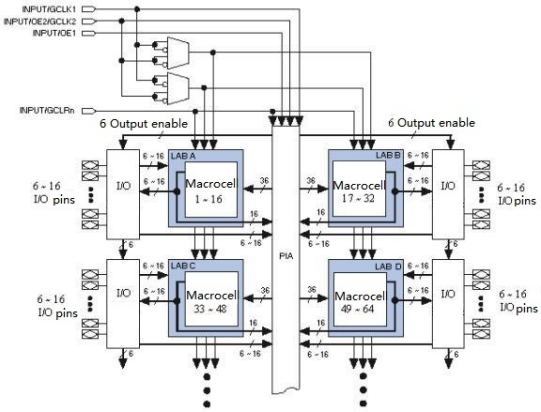A Complex Programmable Logic Device (CPLD) is a type of digital logic device used in digital circuit design and implementation. CPLDs are part of the larger family of programmable logic devices (PLDs), which also includes Field-Programmable Gate Arrays (FPGAs).

Here are some key characteristics and features of CPLDs:
- Programmability: CPLDs are programmable digital logic devices, which means their internal logic functions can be configured or programmed to perform specific tasks or functions. This programming typically involves specifying the logical connections and behavior of the device.
- Logic Blocks: CPLDs consist of a collection of programmable logic blocks that can be configured to perform various logical functions (AND, OR, XOR, etc.). These logic blocks are interconnected to form the desired digital circuit.
- Interconnectivity: CPLDs have a programmable interconnect structure that allows designers to create custom routing for signals between the logic blocks. This flexibility in routing helps in implementing complex logic functions efficiently.
- Inputs and Outputs: CPLDs have a certain number of input pins (for receiving external signals) and output pins (for driving external signals). The number of inputs and outputs varies depending on the specific CPLD model.
- Macrocells: CPLDs often include macrocells, which are configurable elements that can implement various functions, such as flip-flops, latches, and combinational logic. Macrocells are used to store intermediate results and synchronize signals.
- In-System Programming: CPLDs can be reprogrammed in-system, which means they can be updated or modified without removing them from the circuit board. This feature is useful for design iteration and debugging.
- Lower Complexity: CPLDs are generally smaller and have less capacity compared to FPGAs. They are well-suited for simpler logic designs and applications where lower power consumption is desired.
- Deterministic Timing: CPLDs offer deterministic timing characteristics, which means that the propagation delay of signals through the device is predictable and consistent. This feature is essential in applications where timing is critical.
- Applications: CPLDs are often used in a variety of applications, including control systems, glue logic, interface logic, and small-scale digital signal processing (DSP). They are particularly useful for tasks where a custom logic function is needed, but a full-scale FPGA might be overkill in terms of size and power consumption.
Discussions
Become a Hackaday.io Member
Create an account to leave a comment. Already have an account? Log In.